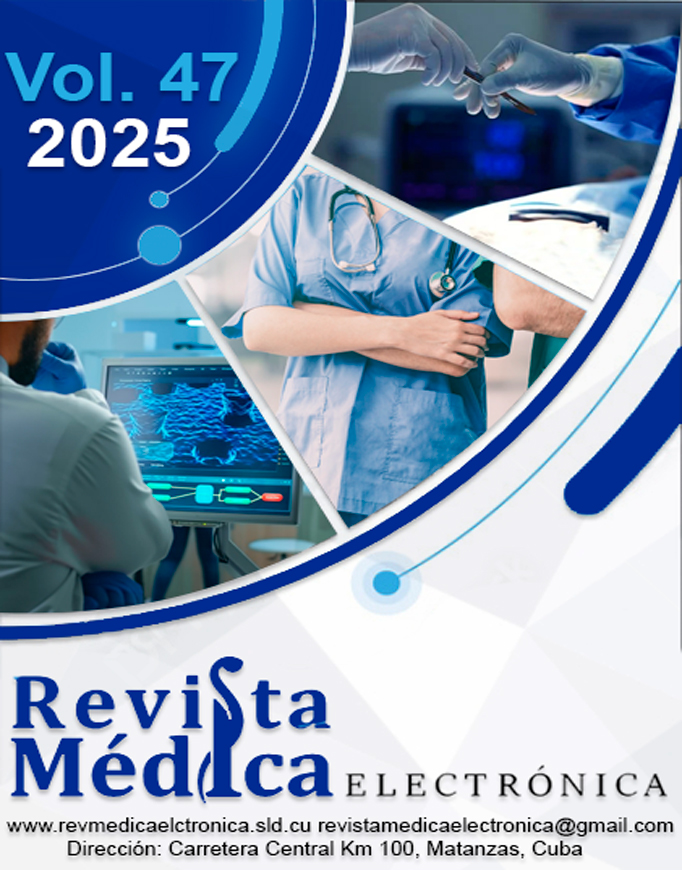Scientific evidence on the antibacterial activity of Rosemary and Japanese Mint on strains of Staphylococcus aureus
Abstract
Introduction: Scientific evidence of the use of Rosmarinus officinalis L. and Menta arvensis, grown in Cuba, as antimicrobials is very limited.
Objective: To demonstrate the antibacterial effect of Rosmarinus officinalis L. and Mentha arvensis, grown in Cuba, against clinical strains of methicillin-resistant Staphylococcus aureus that produce bacterial skin infections and against reference strains
Methods: The fluid extract was obtained by the cold maceration method. The minimum inhibitory and bactericidal concentration was determined by the tube macrodilution method.
Results: The clinical strains of methicillin-resistant Staphylococcus aureus analyzed showed a minimum inhibitory concentration of 6.25 µg/mL and a minimum bactericidal concentration of 12.5 µg/mL, against rosemary extract. The mint extracts showed the minimum inhibitory concentration at 3.1 µg/mL and minimal bactericidal at 6.25 µg/mL. The combined extract enhances the antimicrobial effect.
Conclusions: Rosemary and mint extracts, and their combination, show in vitro antimicrobial activity on clinical strains of methicillin-resistant Staphylococcus aureus and on reference strains. This evidence points to future opportunities for the development of dermatological drugs from medicinal plant extracts.
Downloads
References
1. Makwela AB, Grootboom WM, Abraham V, et al. Antimicrobial Management of Skin and Soft Tissue Infections among Surgical Wards in South Africa: Findings and Implications. Antibiotics. 2023;12(2):275. DOI: 10.3390/antibiotics12020275.
2. GBD 2019 Antimicrobial Resistance Collaborators. Global mortality associated with 33 bacterial pathogens in 2019: A systematic analysis for the Global Burden of Disease Study 2019. Lancet. 2022;400:2221-48. DOI: 10.1016/S0140-6736(22)02185-7.
3. García-Guerra AD, Vázquez-Gutiérrez GL, Osorio-Caballero IM, et al. Morbilidad por infecciones de partes blandas superficiales en el servicio de clínicas pediátricas de Manzanillo, Granma 2018. Rev Inf Cient [Internet]. 2020 [citado 05/04/2023];99(4):340-8. Disponible en: http://www.revinfcientifica.sld.cu/index.php/ric/article/view/2999Ç
4. Ricardo-Mora E, Ávila-Expósito Y, Valdez-Argollo J. Caracterización de pacientes con piodermitis recurrentes atendidos en el hospital provincial de Las Tunas. Rev electrón Zoilo [Internet]. 2022 [citado 05/04/2023];47(2):e3020. Disponible en: http://revzoilomarinello.sld.cu/index.php/zmv/article/view/3020
5. Ez-Zriouli R, El Yacoubi H, Imtara H, et al. Chemical composition and antimicrobial activity of essential oils from Mentha pulegium and Rosmarinus officinalis against multidrug-resistant microbes and their acute toxicity study. Open Chemistry. 2022;20(1):694-702. DOI: 10.1515/chem-2022-0185.
6. García-Guerra AD, Vázquez-Gutiérrez GL, Osorio-Caballero IM, et al. Morbilidad por infecciones de partes blandas superficiales en el servicio de clínicas pediátricas de Manzanillo, Granma 2018. Rev Inf Cient [Internet]. 2020 [citado 29/09/2023];99(4):340-8. Disponible en: http://www.revinfcientifica.sld.cu/index.php/ric/article/view/2999
7. González Rojas LG, Zuleta Arroyave JC. Análisis de impacto normativo buenas prácticas de manufactura de productos fitoterapéuticos [Internet]. Bogotá: Ministerio de Salud y Protección Social de Colombia; 2022 [citado 01/06/2023]. Disponible en: https://www.minsalud.gov.co/Anexos_Normatividad_Nuevo/AIN%20BPM%20Fitoterape%CC%81uticos%20RVF.pdf
8. Canahualpa Vílchez O, Canales Tupac MF. Plantas medicinales utilizadas como alternativa de tratamiento para afecciones de la piel y mucosas en los pobladores del barrio de Pucará – Huancayo [tesis en Internet]. Huancayo: Universidad Roosevelt; 2016 [citado 29/09/2023]. Disponible en: https://docs.bvsalud.org/biblioref/2018/10/915624/plantas-medicinales-utilizadas-como-alternativa-de-tratamiento-_N5FRwPH.pdf
9. Ministerio de Agricultura (FUCOA). 103 plantas medicinales [Internet]. Santiago de Chile: FUCOA; 2018 [citado 29/09/2023]. Disponible en: https://expochileagricola.cl/wp-content/uploads/2021/04/103-HIERBAS-MEDICINALES-FUCOA-2022-1.pdf
10. Gallegos-Zurita M, Gallegos ZD. Plantas medicinales utilizadas en el tratamiento de enfermedades de la piel en comunidades rurales de la provincia de Los Ríos - Ecuador. An Fac med [Internet]. 2017 [citado 29/09/2023];78(3):315-21. Disponible en: http://www.scielo.org.pe/scielo.php?pid=S1025-55832017000300011&script=sci_abstract
11. Moreira SA, Alexandre EMC, Pintado M, et al. Effect of emergent non-thermal extraction technologies on bioactive individual compounds profile from different plant materials. Food Res Int. 2019;115:177-90. DOI: 10.1016/j.foodres.2018.08.046.
12. Ministerio de Salud Pública de Cuba. NRSP 312/91- Medicamentos de origen vegetal extractos fluidos y tinturas. Métodos de ensayo. La Habana: MINSAP; 1991.
13. Clinical and Laboratory Standards Institute. Método de determinación de sensibilidad antimicrobiana por dilución. MIC testing [Internet]. 2012 [citado 29/09/2023];32(2). Disponible en: http://antimicrobianos.com.ar/ATB/wp-content/uploads/2012/11/04-DETERMINACION-DE-LA-SENSIBILIDAD-METODO-DE-DILUCION-2012.pdf
14. González Hernández RM, Romero Martinez V, Delgado Sanchez MM, et al. Actividad antibacteriana del extracto de Mentha arvensis L. (menta japonesa), frente a cepas productoras de piodermitis. Rev Cubana Plant Med [Internet]. 2021 [citado 15/03/2024];25(4):e1164. Disponible en: https://revplantasmedicinales.sld.cu/index.php/pla/article/view/1164
15. Fazeli-Nasab B, Valizadeh M, Hassanzadeh MA, et al. Evaluation of the Antimicrobial Activity of Olive and Rosemary Leave Extracts Prepared with Different Solvents Against Antibiotic-Resistant Escherichia coli. Int J Infect [Internet]. 2021 [citado 15/03/2024];8(3):e114498. https://brieflands.com/articles/iji-114498.pdf
16. Neira LLerena JE. Evaluación de la actividad antimicrobiana de los extractos etanólico de las plantas medicinales utilizados por los pobladores de tuctumpaya, quequeña y chiguata, frente a bacterias Gram positivas: Staphylococcus aureus – Streptococcus pneumoniae causantes de infecciones de importancia médica, Arequipa – Perú 2017 [Internet]. Arequipa: Universidad Nacional de San Agustin de Arequipa; 2018 [citado 15/03/2024]. Disponible en: http://repositorio.unsa.edu.pe/handle/UNSA/6899
17. Karadağ AE, Demirci B, Çaşkurlu A, et al. In vitro antibacterial, antioxidant, anti-inflammatory and analgesic evaluation of Rosmarinus officinalis L. flower extract fractions. S African J Bot. 2019;125:214-20. DOI: 10.1016/j.sajb.2019.07.039.
18. Patel D, Upadhye V, Upadhyay T, et al. Phytochemical Screening and Antimicrobial Activity of Mentha Arvensis L. [Pudina]: A Medicinal Plant. Can J Med Sci. 2021;3(2):67-76. DOI: 10.33844/cjm.2021.60506.
Downloads
Published
Versions
- 2025-03-14 (3)
- 2025-02-12 (2)
- 2025-01-29 (1)
How to Cite
Issue
Section
License
Copyright (c) 2025 Revista Médica Electrónica (Medical Electronic Journal)

This work is licensed under a Creative Commons Attribution-NonCommercial 4.0 International License.
All content published in this journal is Open Access, distributed under the terms of the CC BY-NC 4.0 License.
It allows:
- Copy and redistribute published material in any medium or format.
- Adapt the content.
This will be done under the following terms:
- Attribute the authors' credits and indicate whether changes were made, in which case it must be in a reasonable way.
- Non-commercial use.
- Recognize the journal where it is published.
The copyrights of each article are maintained, without restrictions.






